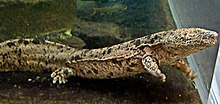|
隱鰓鯢科
隱鰓鯢科(學名:Cryptobranchidae),為隱鰓鯢亞目下之一科。终生生活在水中,成体保有鳃裂,体侧有皮肤褶皱以增加皮肤面积用於在水中呼吸,前肢4趾後肢5趾。 行为日本大鲵的人工饲养寿命长达 52 年[1]。 进食中国大鲵以水生昆虫、鱼、蛙、蟹和虾为食 [2][3]。 由于视力不佳,它们利用头部和身体上的感觉节点探测水压的微小变化,从而找到猎物[4]。 繁殖在交配季节,蝾螈会向上游移动,雌性会在那里产下两串卵,每串 200 多枚[5]。 雄性蝾螈没有其他物种那种刻板的求偶行为,它会在卵上释放精子,使卵在外面受精,然后守护卵至少三个月,直到卵孵化[6]。 在这一阶段,幼虫以明显储存的脂肪为食,直到它们准备好捕食。一旦准备就绪,它们就会成群捕食,而不是单个捕食。 分類泛隱鰓鯢類 Pancryptobrancha
參考文獻
外部連結 |
||||||||||||||||||||||||
Index:
pl ar de en es fr it arz nl ja pt ceb sv uk vi war zh ru af ast az bg zh-min-nan bn be ca cs cy da et el eo eu fa gl ko hi hr id he ka la lv lt hu mk ms min no nn ce uz kk ro simple sk sl sr sh fi ta tt th tg azb tr ur zh-yue hy my ace als am an hyw ban bjn map-bms ba be-tarask bcl bpy bar bs br cv nv eml hif fo fy ga gd gu hak ha hsb io ig ilo ia ie os is jv kn ht ku ckb ky mrj lb lij li lmo mai mg ml zh-classical mr xmf mzn cdo mn nap new ne frr oc mhr or as pa pnb ps pms nds crh qu sa sah sco sq scn si sd szl su sw tl shn te bug vec vo wa wuu yi yo diq bat-smg zu lad kbd ang smn ab roa-rup frp arc gn av ay bh bi bo bxr cbk-zam co za dag ary se pdc dv dsb myv ext fur gv gag inh ki glk gan guw xal haw rw kbp pam csb kw km kv koi kg gom ks gcr lo lbe ltg lez nia ln jbo lg mt mi tw mwl mdf mnw nqo fj nah na nds-nl nrm nov om pi pag pap pfl pcd krc kaa ksh rm rue sm sat sc trv stq nso sn cu so srn kab roa-tara tet tpi to chr tum tk tyv udm ug vep fiu-vro vls wo xh zea ty ak bm ch ny ee ff got iu ik kl mad cr pih ami pwn pnt dz rmy rn sg st tn ss ti din chy ts kcg ve





